Overview
The article addresses the critical issue of application network optimization, offering expert insights for IT managers aimed at enhancing system performance and user experience. It underscores the necessity of strategies such as:
- Prioritizing user experience
- Leveraging automation
- Conducting regular training
Supported by compelling examples and statistics, these practices demonstrate a significant positive impact on operational efficiency and customer satisfaction.
How can these strategies transform your organization? By implementing these best practices, you not only improve performance but also elevate user satisfaction, making a compelling case for action.
Introduction
In the rapidly evolving landscape of digital transformation, the optimization of application networks has emerged as a critical focus for organizations striving to enhance performance and maintain a competitive edge. This comprehensive process blends strategies aimed at improving reliability, reducing latency, and streamlining communication across diverse network environments. As businesses increasingly depend on technology to drive productivity and user satisfaction, understanding the intricacies of application network optimization is essential.
How can organizations effectively integrate legacy systems, implement real-time monitoring, and ensure robust security measures?
Adopting a holistic approach that aligns technical capabilities with overarching business goals is crucial. This article delves into the key components, best practices, and expert insights that can empower organizations to navigate the complexities of application network optimization effectively.
Understanding Application Network Optimization
Optimization of systems encompasses a variety of strategies and techniques designed to enhance the performance, reliability, and efficiency of application networks. This critical procedure is vital for managing bandwidth, minimizing latency, and ensuring seamless communication among systems in diverse connectivity environments. By effectively optimizing software systems, organizations can significantly improve user experiences, lower operational costs, and boost overall productivity.
Key elements of successful enhancement in application networks include a thorough understanding of system architecture, traffic patterns, and the specific requirements of the software in use. Organizations that implement robust optimization strategies often report latency reductions of up to 30%, leading to faster response times and increased user satisfaction. Avato’s dedicated hybrid integration platform ensures 24/7 availability for essential integrations, underscoring the reliability aspect of system optimization, especially in critical sectors such as banking, healthcare, and government.
A holistic approach to application networks is essential for effective optimization, integrating both technical and business perspectives. This alignment ensures that IT strategies address immediate concerns while also supporting broader organizational goals. Recent developments in 2025 indicate a growing emphasis on real-time monitoring tools, such as the nGenius Enterprise Management solution, which allows IT managers to continuously assess software performance and make data-driven adjustments.
Practical examples illustrate the impact of optimizing software systems on user experience. For instance, a financial institution that embraced Avato’s advanced optimization techniques experienced a 25% increase in transaction speed, directly enhancing customer satisfaction and retention. Moreover, industry leaders recommend prioritizing bandwidth management and latency reduction as foundational components of any application network optimization strategy.
Sayantani Mazumder, a manager at the Deloitte Center for Technology, Media & Telecommunications, emphasizes the necessity for companies to navigate emerging trends and challenges in effectively optimizing software connectivity.
Best practices for enhancing software connectivity efficiency in application networks include:
- Regular traffic evaluations
- Leveraging cloud-based solutions for scalability
- Investing in energy-efficient technologies to meet sustainability goals
A recent case study highlights that tech companies are encouraged to focus on energy-efficient technologies as energy consumption in data centers escalates due to digital transformation. As organizations grapple with the complexities of this transformation, the importance of application optimization becomes clear; it is a vital component for maintaining a competitive edge in today’s fast-paced business environment.
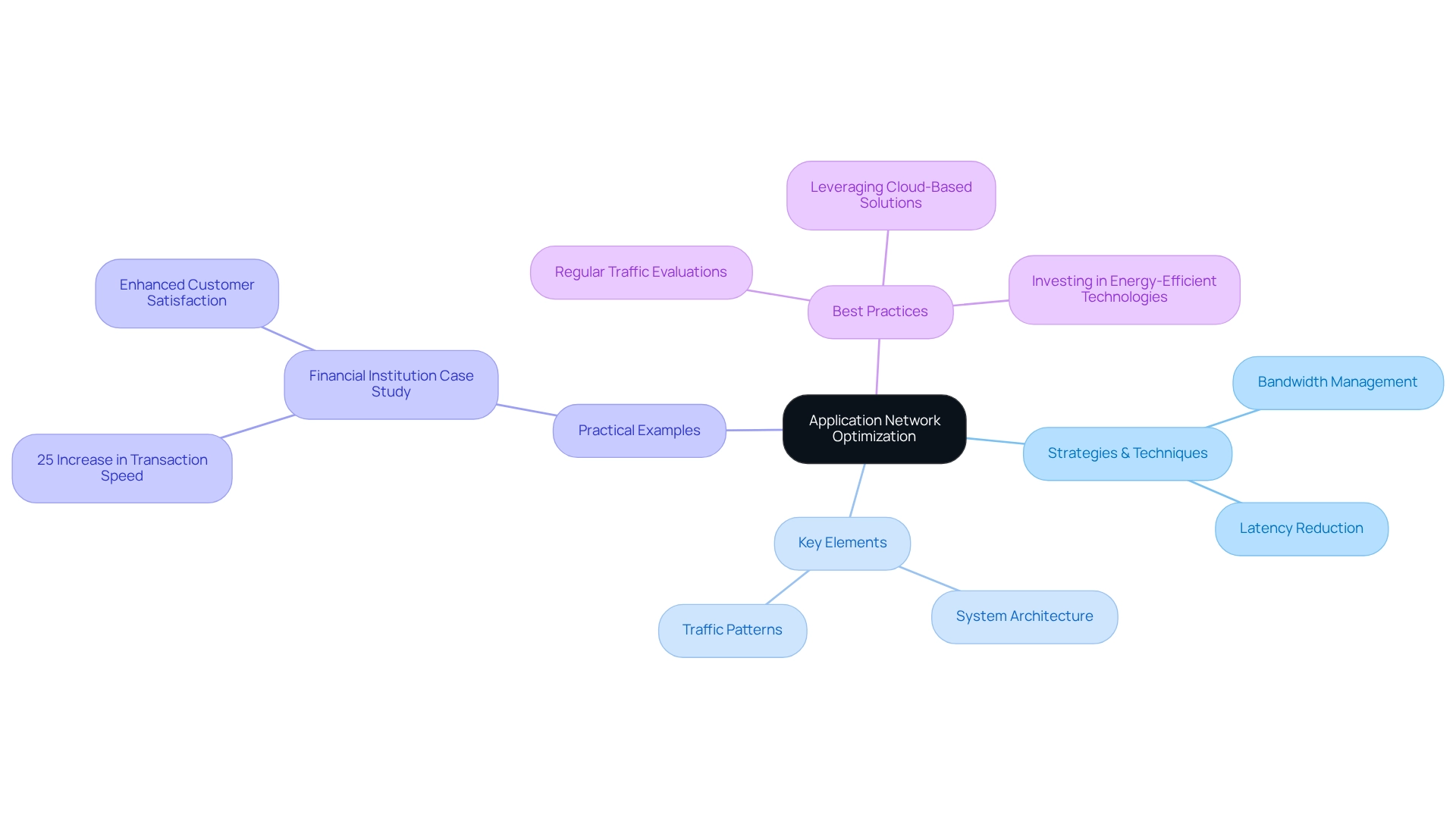
Assessing Your Current Network Performance
To evaluate the effectiveness of your current system, establishing key performance indicators (KPIs) such as bandwidth utilization, latency, packet loss, and error rates is essential. Recent statistics indicate that nearly 10% of IT specialists plan to invest in monitoring tools within the coming year, underscoring the growing recognition of their importance in performance analysis. By utilizing advanced network monitoring tools, you can collect data on these metrics over time, facilitating a comprehensive analysis of network behavior.
Regular audits are crucial for identifying underperforming components, which may include outdated hardware or misconfigured settings. Avato’s hybrid integration platform is pivotal in addressing these challenges through its application network, streamlining the integration of legacy systems and ensuring all components work harmoniously. Furthermore, integrating user feedback provides valuable insights into real-world challenges that metrics alone may not capture.
This data-driven approach not only pinpoints specific areas requiring attention but also informs your optimization strategy moving forward.
As Doug Barney, a Tech Evangelist, points out, “KPIs can vary for each organization, as their business objectives are distinct and requirements are individual.” This highlights the necessity of tailoring your KPIs to fit your organization’s unique context.
For instance, assessing device latency and packet loss together can serve as an early warning system for potential issues, as increases in these metrics often correlate with a decline in user experience and service delivery. By focusing on these essential elements, IT managers can enhance their system’s efficiency and ensure a more reliable infrastructure.
In 2025, the landscape of connectivity monitoring continues to evolve, with new tools emerging that offer advanced analytical capabilities. Engaging with insights from system efficiency analysts can further assist in selecting suitable monitoring tools tailored to your organization’s specific needs. Additionally, tracking intrusion attempts is vital for evaluating the resilience of cybersecurity measures, providing insights into the intensity and frequency of cyber threats.
By adopting a proactive and informed approach to performance assessment, you can significantly enhance operational efficiency and user satisfaction. Moreover, addressing the challenges of integrating legacy systems, as evidenced in case studies of Avato’s hybrid integration platform, can further bolster your strategy. Avato’s commitment to streamlining diverse systems and increasing business value ensures that your application network is robust and capable of supporting your organization’s objectives.

Integrating Legacy Systems for Seamless Operations
Integrating legacy systems into modern application networks is a strategic necessity. Begin by evaluating the capabilities of your legacy systems and pinpointing opportunities for collaboration with contemporary technologies. Middleware solutions and APIs are essential in bridging communication gaps between disparate systems, facilitating seamless data exchange.
Establishing data transformation layers is vital to ensure compatibility and preserve data integrity throughout the merging process.
Security must be prioritized; the adoption of modern security protocols is crucial for protecting sensitive data during transfers. This strategic unification not only boosts operational efficiency but also allows organizations to maximize their investments in legacy technology within their application networks while advancing their infrastructure. Avato guarantees 24/7 availability for critical connections, enhancing the reliability of the connection process, which is essential in sectors like banking, healthcare, and government.
Since its inception in 2010, Avato’s hybrid connection platform has transformed financial institutions, yielding cost reductions, faster product delivery, and improved customer satisfaction. For example, Avato’s collaboration with Coast Capital, which launched in February 2013, demonstrated its capability to facilitate significant system transitions with minimal downtime, including a mere 63-second outage during a major switch of their telephone banking system. Recent studies indicate that 25% of supply chain companies may incur losses exceeding $500K annually due to inadequate business process integration, underscoring the necessity of effective coordination strategies.
As organizations increasingly invest in modern connection solutions that prioritize ecosystem collaboration for sustainable value creation, leveraging middleware solutions becomes imperative. As customer Gustavo Estrada remarked, “Avato has simplified complex projects and delivered results within desired time frames and budget constraints.” This highlights the importance of equipping leadership with the right tools and insights, essential for effectively advocating digital transformation efforts. Thus, the integration of legacy systems emerges as a critical step in modernizing software infrastructures.
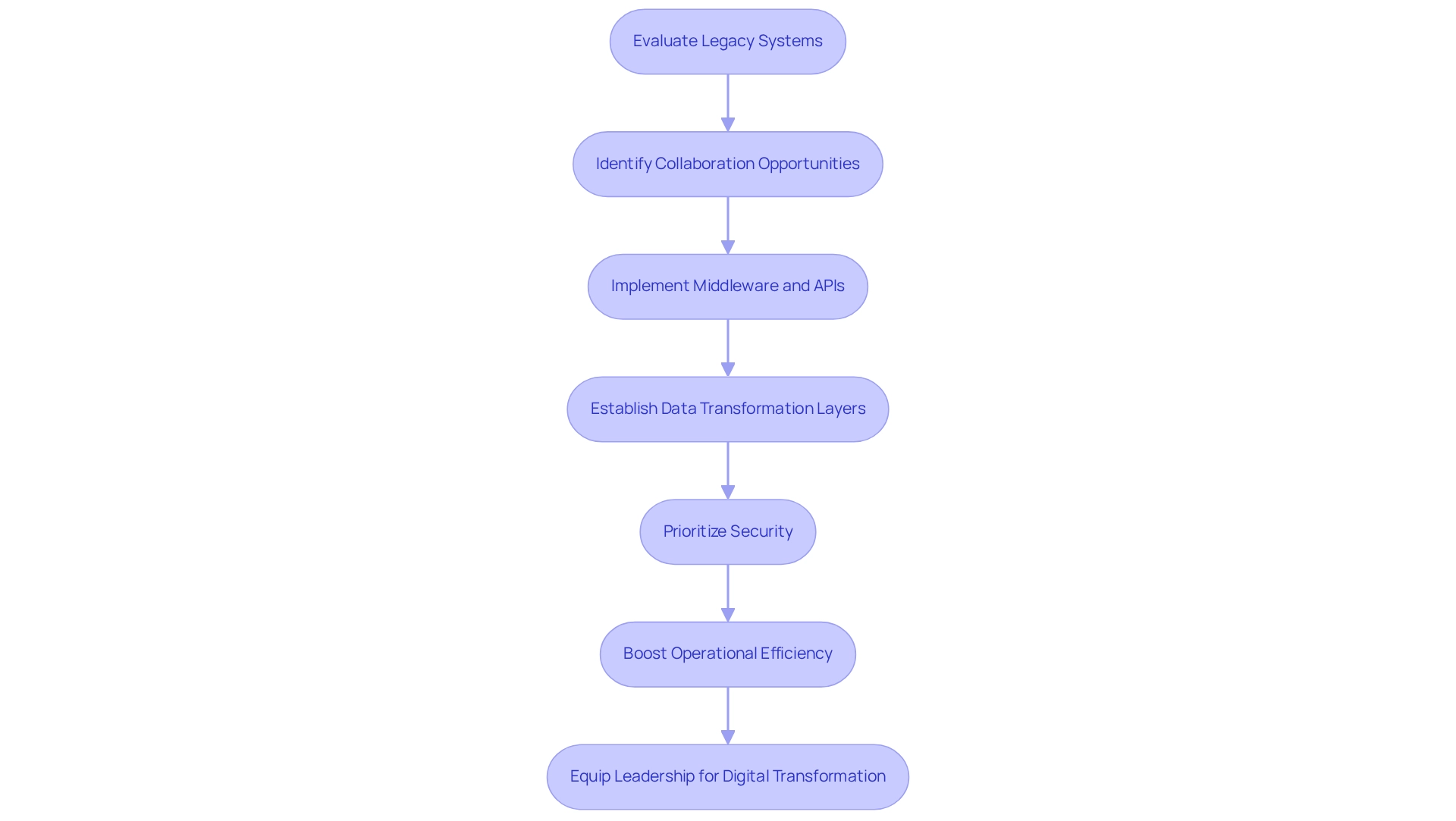
Implementing Real-Time Monitoring and Alerts
To implement effective real-time monitoring, selecting a comprehensive network monitoring solution that provides visibility across all facets of your application network is essential. Begin by establishing alerts for critical metrics, such as bandwidth usage, latency spikes, and error rates. It is crucial to set clear thresholds for these metrics to ensure alerts are triggered when results deviate from expected standards.
Regularly reviewing and refining alert configurations is vital to minimize unnecessary notifications, enabling IT teams to concentrate on actionable insights. This proactive strategy not only enhances connectivity reliability but also significantly boosts user satisfaction.
The importance of real-time monitoring in enhancing system performance cannot be overstated. Statistics indicate that nearly 10% of IT experts plan to invest in monitoring tools in the coming year, underscoring a growing recognition of its value. Effective alert configurations are instrumental in this process; they empower IT teams to respond swiftly to potential issues, thereby ensuring operational continuity.
As Gustavo Estrada remarked, “Avato has the ability to simplify complex projects and deliver results within desired time frames and budget constraints,” underscoring the effectiveness of real-time monitoring solutions in achieving these objectives.
A pertinent case study in the agriculture sector exemplifies the power of real-time monitoring. By harnessing real-time data, organizations enhanced product quality and safety, improving traceability within food supply chains. The findings from this study suggest that real-time monitoring not only optimizes data collection but also mitigates environmental impacts while ensuring the safety of food products.
Looking ahead to 2025, current trends in alert configurations are evolving, with an emphasis on integrating advanced analytics and machine learning to predict and address issues before they escalate. Understanding related metrics is essential, as they can significantly influence experiments and outcomes in system performance. Moreover, recognizing the distinction between surrogate and intrinsic metrics is crucial for IT managers striving to maintain a competitive edge in an increasingly complex digital landscape.
Expert opinions stress that adopting these innovative real-time monitoring solutions is imperative for IT managers seeking to sustain a competitive advantage in today’s intricate digital environment.
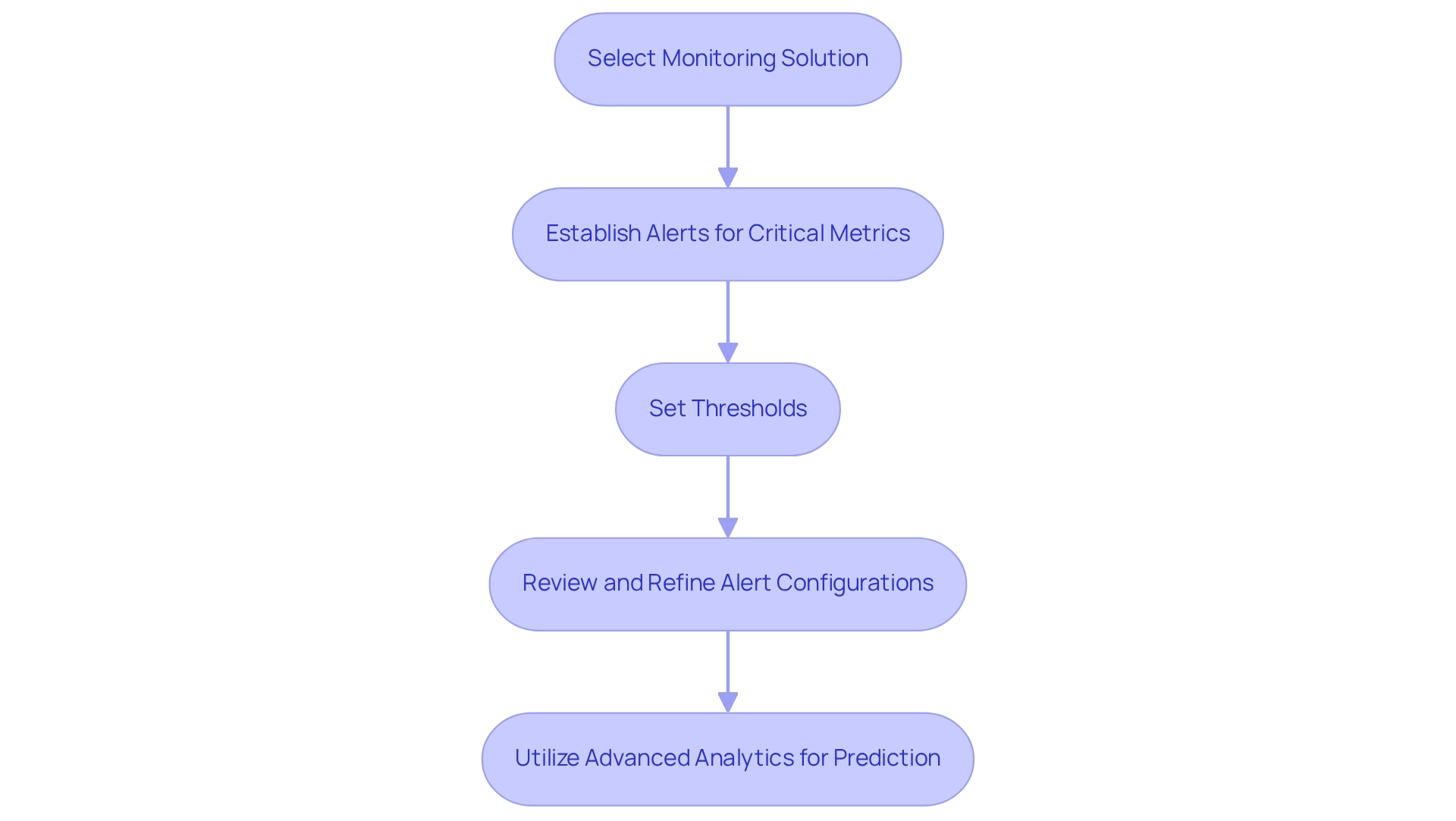
Ensuring Security and Compliance in Network Optimization
To ensure security and compliance during system optimization, beginning with a comprehensive risk assessment that identifies vulnerabilities within your application infrastructure is crucial. This proactive approach empowers organizations to prioritize security measures effectively. Implementing robust security protocols—such as encryption, stringent access controls, and regular security audits—is essential for safeguarding sensitive data against potential breaches, particularly in sectors like banking, healthcare, and government, where Avato’s secure hybrid integration platform excels.
Staying informed about the latest compliance requirements for network security in 2025 is vital. Recent statistics reveal that 4.6% of vulnerabilities in web applications are classified as critical, with this figure escalating to 8% for applications processing payment card data. Such data underscores the importance of aligning optimization strategies with current regulations to mitigate risks.
The presence of these vulnerabilities highlights the necessity of implementing strong security measures to protect sensitive information, a core feature of Avato’s platform designed for integration projects requiring 24/7 uptime with no room for defects or outages.
Adopting a zero-trust security model can further enhance your organization’s security posture. This model operates on the principle that threats may originate from both external and internal sources, necessitating stringent verification for every user and device attempting to access the network.
Moreover, case studies reveal that many organizations struggle with traditional application security processes that fail to keep pace with evolving cybersecurity threats. As noted in the case study titled “Assessing and Addressing Application Security Vulnerabilities,” effective risk prioritization based on reachability, exploitability, and business impact is essential for organizations to manage vulnerabilities efficiently and focus on critical issues. This approach is crucial for ensuring that security measures are both effective and aligned with business objectives, particularly when leveraging Avato’s hybrid integration platform for digital transformation.
Expert insights highlight the significance of incorporating security measures into system optimization strategies. As organizations navigate the complexities of compliance and security, leveraging advanced technologies and methodologies will be key to maintaining a secure and compliant application network. As Gustavo Estrada from BC Provincial Health Services Authority stated, “Avato has the ability to simplify complex projects and deliver results within desired time frames and budget constraints,” emphasizing the effectiveness of robust security measures in achieving compliance and security goals.
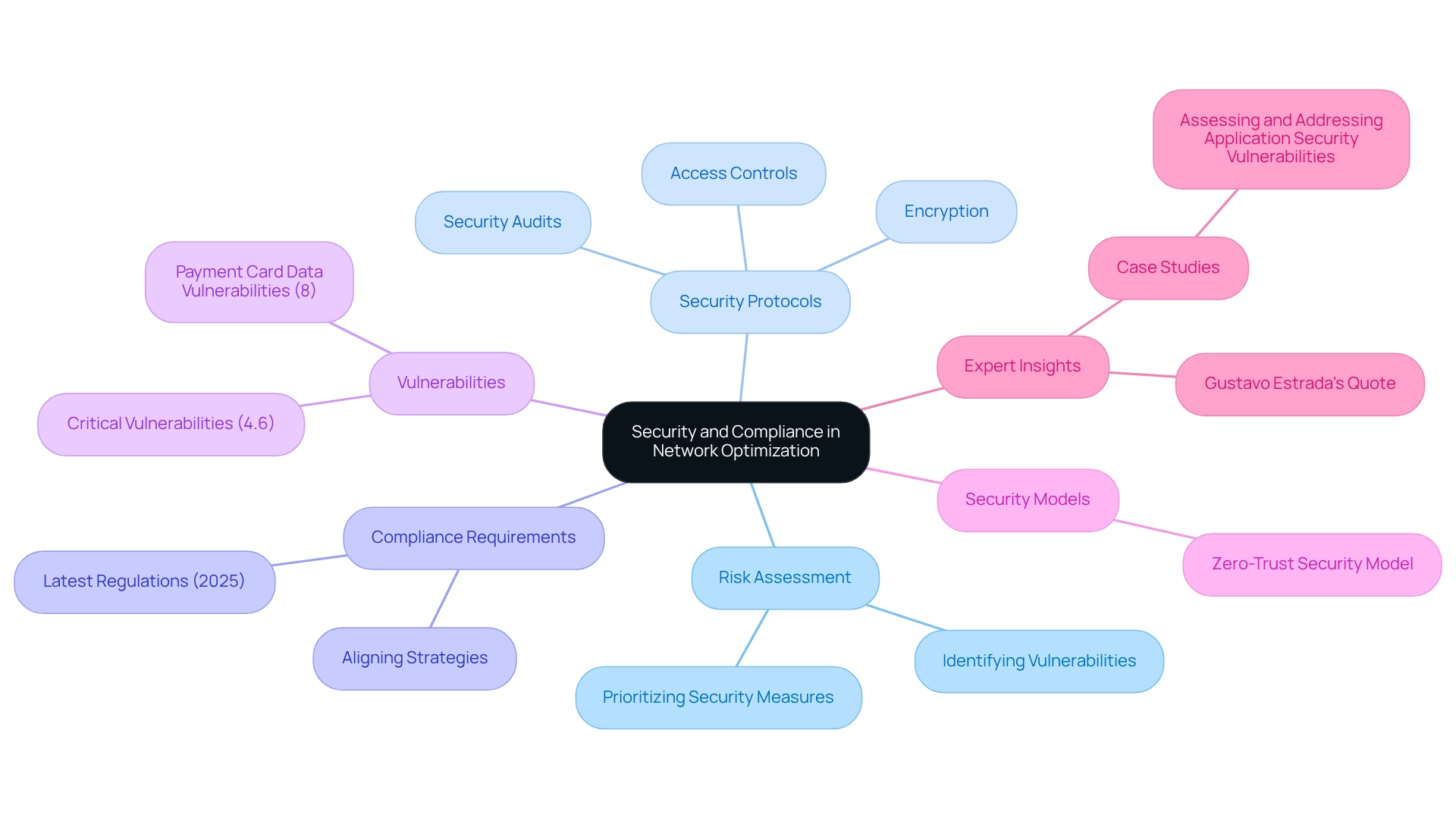
Fostering Interdepartmental Collaboration
To cultivate interdepartmental collaboration, establishing clear communication channels and promoting regular meetings between IT and other departments is essential. Forming cross-functional teams for specific projects enables organizations to harness diverse expertise and perspectives, leading to innovative solutions. Implementing collaborative tools and platforms enhances information sharing and streamlines project management, facilitating effective teamwork.
Avato’s dedicated hybrid integration platform plays a crucial role in this process by simplifying the integration of disparate systems and data. By unlocking isolated assets, Avato empowers businesses to create significant value and enhance collaboration across departments. Establishing shared objectives and key success indicators (KPIs) that require input and collaboration from various departments is essential.
This alignment ensures that all teams are working towards common objectives, fostering a sense of shared purpose. Such a collaborative method not only enhances network functionality but also fosters innovation and efficiency across the organization.
Statistics indicate that less than 50% of survey respondents believe their organizations engage in truthful and effective discussions about issues, highlighting the need for improved communication strategies. As Nilofer Merchant, an author and workplace strategist, states, “Everyone is better off when they know why decisions are made with as much accuracy as possible. It gives them an understanding of what matters and provides information on which to base the trade-offs constantly being made at every level.”
This underscores the importance of transparency in decision-making.
Furthermore, current trends show that open office layouts can increase collaboration by up to 62%, encouraging spontaneous interactions and knowledge sharing. Additionally, the case study titled “Thriving Together: How to Build a Strong Team Culture” illustrates that healthy teams that communicate effectively, trust each other, and achieve shared goals experience higher productivity, profitability, and innovation. By emphasizing interdepartmental cooperation and utilizing Avato’s hybrid connection platform, organizations can establish a more agile and responsive IT environment within their application network, ultimately resulting in enhanced performance and competitive edge.
Avato, which stems from the Hungarian word for “of dedication,” embodies a commitment to architecting the technology foundation required to power rich, connected customer experiences. This dedication is reflected in the platform’s capabilities within the application network, which are designed to facilitate seamless integration and collaboration across various departments.
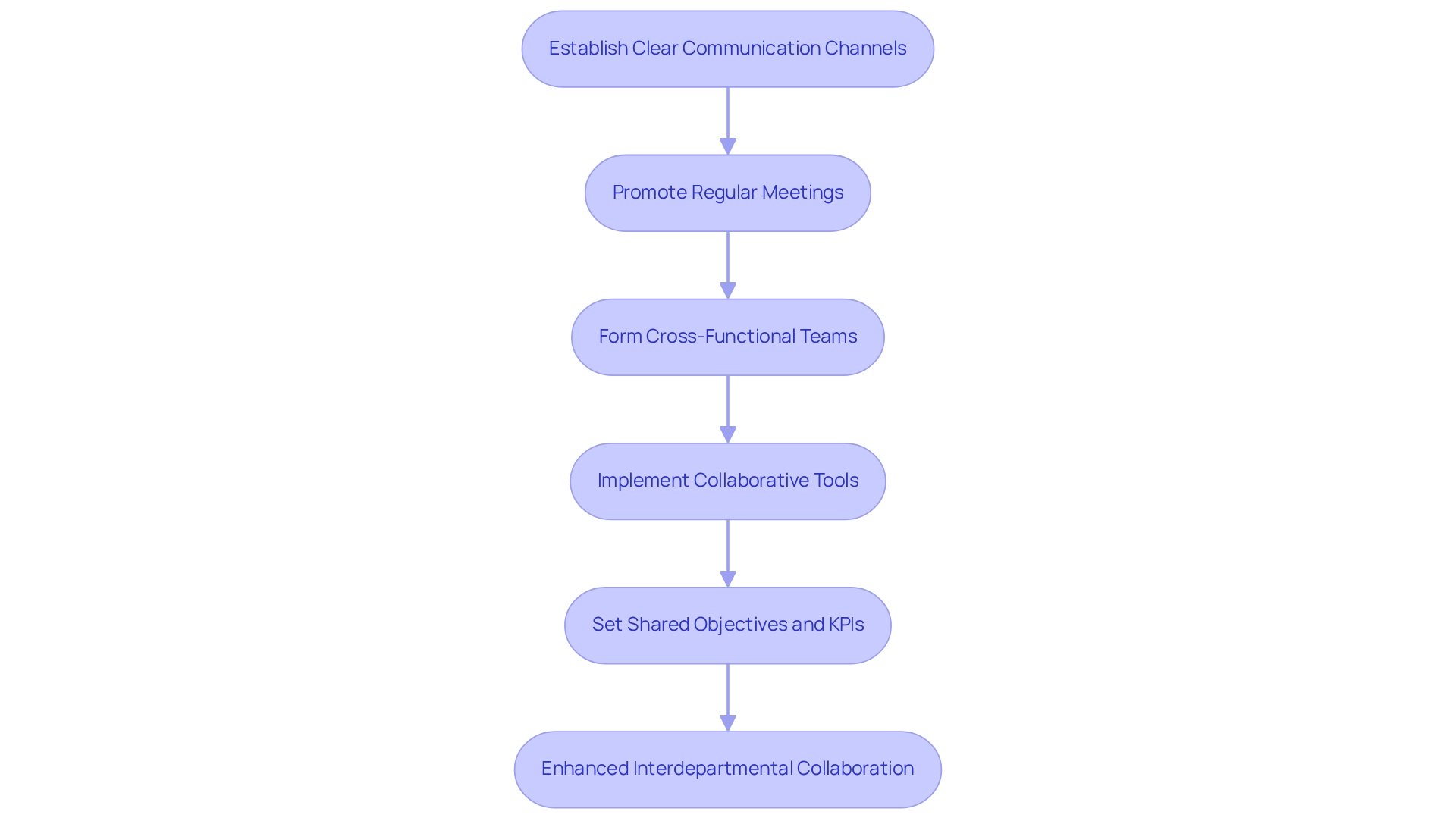
Expert Tips for Effective Application Network Optimization
-
Prioritize User Experience: The end-user experience is paramount when enhancing system connections. Fast-loading programs are crucial; data indicates that 60% of Gen Z users will abandon a platform or website that is too slow. Ensuring that applications within the application network function consistently under varying connectivity conditions not only retains users but also boosts overall satisfaction and engagement. Annemarie Bufe, Content Manager, asserts, “Investing in UX design can bring numerous benefits to a company and is well worth the investment.” Furthermore, the case study of Staples’ UX-centered site overhaul effectively illustrates this principle; the redesign resulted in an impressive 500% growth in online revenue, underscoring the direct impact of effective UX design on business outcomes.
-
Utilize Automation: Automation tools are essential for simplifying management tasks, such as configuration modifications and monitoring efficiency. By minimizing the potential for human error, these tools enhance both efficiency and reliability. Organizations that embrace an application network can significantly reduce downtime and improve response times, leading to a more robust system environment. John Johnstone from OSME Pacific commends Avato for its ability to simplify complex projects and deliver results within desired time frames and budget constraints, highlighting automation’s effectiveness in achieving operational goals.
-
Consistently Refresh Infrastructure: Keeping your system infrastructure up-to-date with the latest hardware and software is critical for optimal functionality and security. Regular updates not only enhance speed but also safeguard against vulnerabilities, ensuring that your organization can adapt to evolving threats and demands.
-
Conduct Regular Training: Continuous training for IT personnel on the latest technologies and best practices in system optimization is vital for sustaining a proficient workforce. This investment in human resources ensures that your team is equipped to utilize new tools and methods efficiently, ultimately leading to enhanced system effectiveness.
-
Benchmark Evaluation: Regular benchmarking of network efficiency against industry standards is crucial for identifying areas for improvement. This practice helps organizations maintain competitiveness by ensuring they meet or exceed performance metrics, thereby enhancing user experience and operational efficiency. Additionally, utilizing JSON instead of XML for data exchange can streamline processes, reducing markup overhead and improving data transfer efficiency, particularly in connection platforms. JSON is particularly advantageous when dealing with data that requires quick parsing and minimal overhead, making it a preferred choice in many scenarios. Moreover, investing in UX design can save a company money in the long run by decreasing the need for costly redesigns and updates. It is also essential to consider regulatory compliance and security audits as part of Avato’s hybrid integration solutions, ensuring that all data handling adheres to industry standards and protects sensitive information.
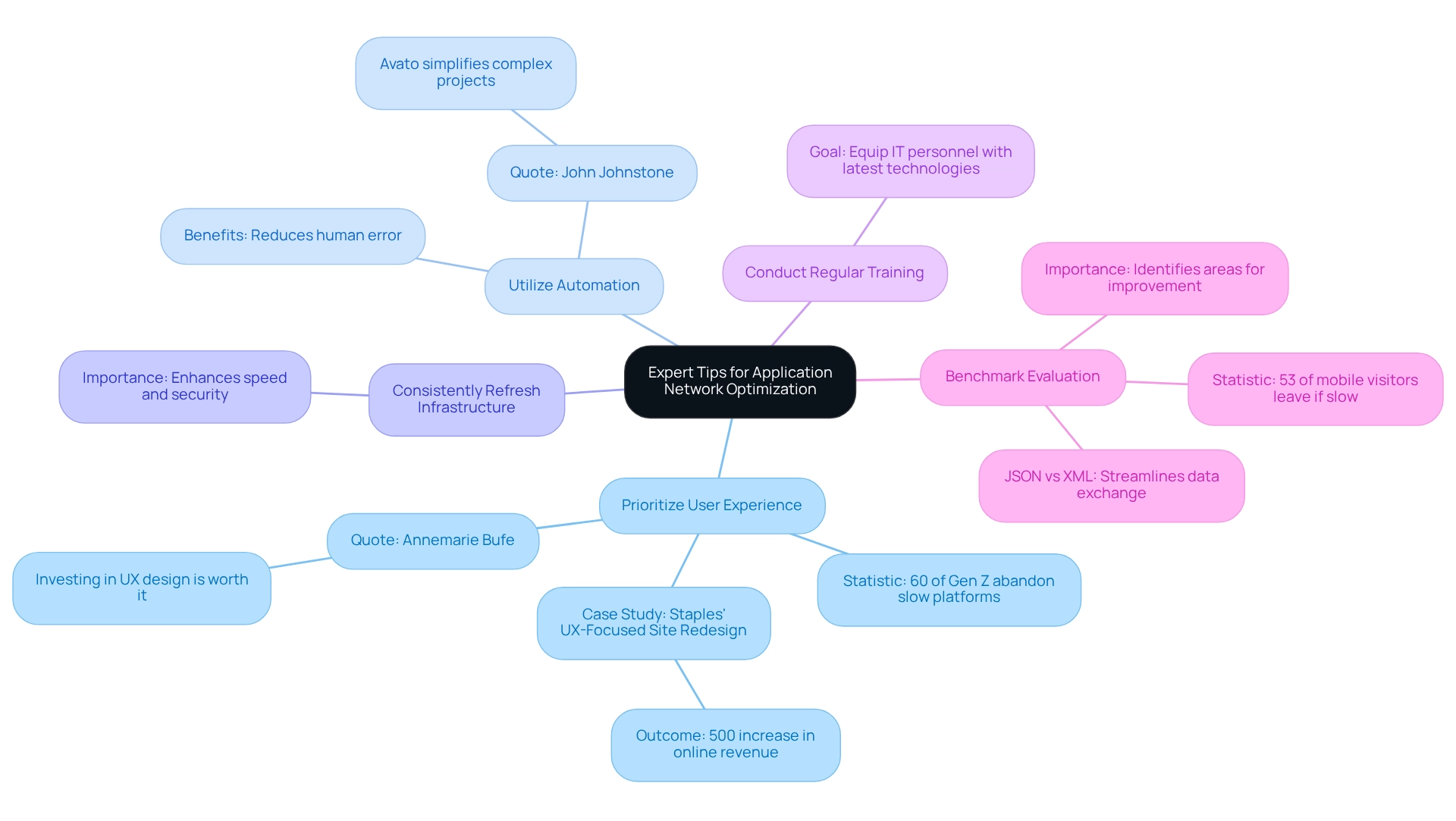
Conclusion
Application network optimization stands as a critical strategy for organizations aiming to excel in today’s competitive digital landscape. By grasping and executing essential components—such as real-time monitoring, legacy system integration, and robust security measures—businesses can significantly enhance their operational efficiency and user satisfaction. The incorporation of advanced technologies, including automation and cloud-based solutions, further empowers organizations to streamline processes and minimize latency, ultimately leading to superior performance.
Furthermore, fostering interdepartmental collaboration and establishing clear communication channels ensures that all teams are aligned with shared objectives. This collaborative approach not only fuels innovation but also amplifies the overall effectiveness of application network optimization strategies. As organizations navigate the complexities of digital transformation, prioritizing user experience remains crucial, as evidenced by its substantial impact on customer retention and engagement.
In conclusion, adopting a holistic approach to application network optimization is not merely a technical necessity; it is a strategic imperative that aligns IT capabilities with business goals. By embracing best practices and leveraging expert insights, organizations can build resilient and adaptable networks that support growth and success in an ever-evolving digital environment. The time to act is now; organizations must commit to optimizing their application networks to secure a competitive edge and drive sustainable value in the future.

